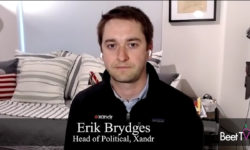Another year, another US midterm election. But the 2022 cycle is one marked by contradictory media trends.
On the one hand, the deprecation of device identifiers challenges candidates trying to target individual voters. On the other, the rise of connected TV (CTV) and over-the-top (OTT) services makes the influential TV screen supremely targetable.
In this video interview with Beet.TV, Mark Jablonowski, Managing Partner & CTO, DSPolitical, an ad platform and network for Democratic candidates, offers his view on the 2022 midterm ad approach.
Finding viewers after SVOD
Jablonowski acknowledges that candidates have to respond to the rise of new TV technologies.
But he suggests it is not so simple – after all, with so many ad-free viewing opportunities, many voters are now less exposed to advertising.
“If someone cuts the cord and they are now subscribing to Netflix and ad-free version of Hulu, in order to reach that voter, you may not be able to do that necessarily directly with the standard CTV,” Jablonowski says.
“You have to go to other sources online, whether it be programmatic video or other direct placements for sites that that user would ultimately be on.”
We believe it will be challenging to replicate the momentum of a unique 2020 campaign season in the U.S. in 2022. https://t.co/gsiHDR3ORc
— Kantar (@Kantar) August 27, 2021
CTV’s midterm moment
Despite SVOD, a growing number of AVOD services has launched on CTV, bringing advertisers new opportunities.
Midterm ad spending will reach $7.8 billion for local broadcast, local cable/satellite, radio, digital and OTT, according to Kantar, whose growth forecast lags other organisations’.
Notably, Kantar estimates OTT/CTV ad spending will hit $1.2 billion, while broadcast TV will grow 30% to $3.8 billion but cable/satellite spending will decline versus 2018.
Other estimates include AdImpact‘s, which expects CTV spending ($1.5 billion) to eclipse the “digital” category (mobile, desktop and tablet).
AdImpact actually estimates 2022 midterm ad spending to decline versus 2020, despite that year having doubled from the previous campaign.
The phaseout of internet tracking cookies is causing chaos for political campaigns that need to pivot quickly before next year's midterms
— New estimates suggest that campaigns will spend more on highly-unregulated digital TV ads than ads on mobile/desktophttps://t.co/x3nqGGoGs2 pic.twitter.com/Dgdvv2mW7i— Sara Fischer (@sarafischer) October 12, 2021
Wide and narrow
Jablonowski says candidates have a tricky balance between going broad and using precision targeting.
“It’s important to make sure that you’re not going too small, too precise, and really slicing and dicing your audience too far, where you’re losing the broader connective messaging that will bring campaigns together,” he says.
“In a linear world, you do have a much larger buy that is less data-targeted, but really getting you message out in a broad way.
“That’s something that you also have to be able to replicate in a digital environment.”
You are watching “Programmatic and Political Advertising,” a Beet.TV Leadership Series presented by Xandr. For more videos, please visit this page.





























